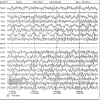A Case of Frequent Blinking and Abnormal Eyeball Movement Associated with Generalized Epilepsy
- PMID: 38884037
- PMCID: PMC11170254
A Case of Frequent Blinking and Abnormal Eyeball Movement Associated with Generalized Epilepsy
Abstract
Eyelid myoclonus is an idiopathic generalized epileptic syndrome that can occur with or without absence seizures. The features include frequent blinking, an upward roll of the eyeballs, and slight backward movement of the head. It can be spontaneous or stimulated by light. Light and eyelid closure are triggers to the seizures. A 13-year-old young male student presented with a four months history of frequent blinking and abnormal eye movements. There was a positive history of leg tapping while asleep which started a year prior to presentation, but there was no loss of consciousness. On presentation, the patient was a young healthy looking myope who frequently blinks with sudden upward and left jerky movements of the eyeballs. Visual acuity was CF at 2 meters in both eyes improving with -4.50DS to 6/6. Intraocular pressures were 12 mmHg bilaterally. Anterior and posterior segment findings were normal. Brain MRI was normal, but EEG was abnormal with features suggestive of generalized epilepsy. He was co-managed with the neurologist and placed initially on Tabs Sodium valproate 250mg for 3 months. This was modified to Tabs Sodium Valproate (controlled release) 500mg at night since there was little change. This resulted in an appreciable reduction in blinking and abnormal eye movement. The leg tapping stopped on this dose. Eyelid myoclonus (EM) is a rare form of epilepsy. It is of utmost importance to create awareness of the disease among physicians. Early diagnosis and treatment are important prognostic factors of the disease. Key Messages: There is a need to create awareness of Eyelid Myoclonus among physicians as this can easily be missed or misdiagnosed.
Keywords: Abnormal Eye Movement; Eyelid Myoclonus; Frequent Blinking; Generalised Epilepsy; Jerky Leg Movement; Sodium Valproate.
Copyright © 2023 Nigerian Medical Association.
Figures



References
-
- Yuan Y, Yang F, Huo L, et al. Case Report: A Case of Eyelid Myoclonic Status with Tonic-Clonic Seizure and Literature Review. Front Pediatr. 2021; 9:671732. Published 2021 Apr 22. doi:10.3389/fped.2021.671732 - DOI - PMC - PubMed
-
- Fisher RS. The New Classification of Seizures by the International League against Epilepsy 2017. Curr Neurol Neurosci Rep. 2017; 17:48. doi:10.1007/s11910-017-0758-6 - DOI - PubMed
-
- Viravan S, Go C, Ochi A, Akiyama T, Carter Snead O 3rd, Otsubo H. Jeavons syndrome existing as occipital cortex initiating generalized epilepsy. Epilepsia. (2011) 52:1 273–9.doi:10.1111/j.1528-1167.2011.03068.x - DOI - PubMed
-
- Giraldez BG, Serratosa JM. Jeavons syndrome as an occipital cortex initiated generalized Epilepsy: further evidence from a patient with a Photic-induced occipital seizure. Seizure. 2015; 32:72 – 4. doi: 10.1016/j.seizure.2015.09.003 - DOI - PubMed
-
- Yetman D and York-Morris S. Identifying and Treating Nocturnal Seizures, Epilepsy and seizures during sleep [Internet] Healthline Media a Red Ventures Company; [Updated 2021/12/7 ;cited 2022/7/9]. Available from https://www.healthline.com/health/epilepsy/nOcturnal-seizures.
Publication types
LinkOut - more resources
Full Text Sources
